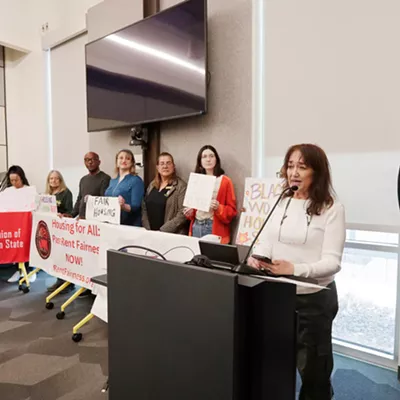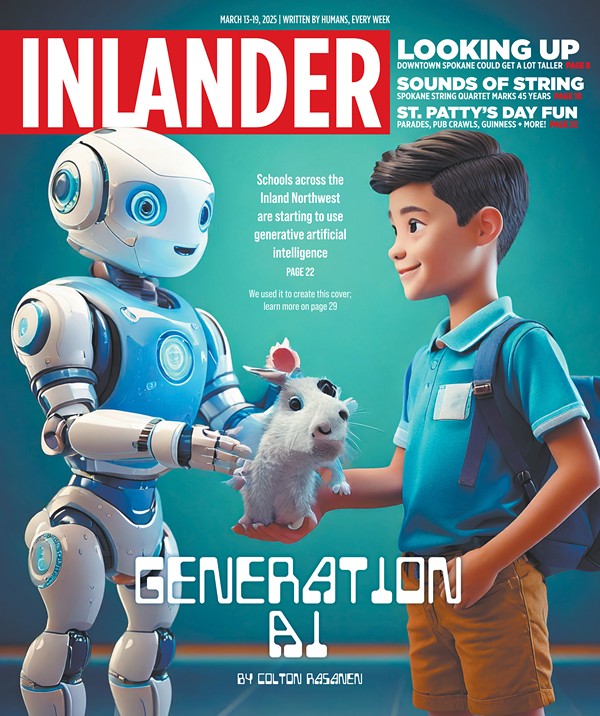For most of 2001, I've worked in a temporary position behind the scenes in the Collections Department at the Northwest Museum of Arts & amp; Culture, as the organization has undergone its latest major expansion. That's not Collections as in money, incidentally, but rather, collections of artifacts and archives. This is the part of museum work that takes place mostly out of the public view, and yet it supports all of the exhibitions and other public programming that get most of the attention. From my little work space deep within the bowels of the museum campus, I see many things...
Mid-September
The moving van pulls up to the west side of the original Cheney Cowles building. We're using a personnel door (architects' fancy name for a door built for people, not freight) because we can't use the loading dock. No need to go into that here; you've all heard about the loading dock. Museum employees, volunteers and a cheerful crew from DeVries Moving & amp; Storage work in shirt sleeves in the September sunshine. A rolling cart is wheeled off the truck, down a ramp, onto a platform, in through the door, down a corridor, around a corner, to another corridor -- avoiding the construction workers who must use the same hallways to transport material -- along the concrete floor, into the smaller of two freight elevators, down a level, and into one of four secure, climate-controlled storage rooms. Because the boxes on the cart hold valuable and often fragile artifacts, museum employees are stationed at strategic points along the journey, checking manifests, taking inventory, and carefully moving items onto shelves. This cart is one of nearly 700 carts moved; the 10 boxes make a tiny dent in the inventory of more than 6,000 boxes.
Mid-October
The end of the move is in sight. We're down to the last few oversized pieces that cause a disproportionate share of the headaches. The loading dock is fixed now, so the moving van backs right into the lower level of the new building. But the path from truck to storage is not any shorter. Each large piece must be wrestled onto a dolly or four-wheeler, then maneuvered down a long corridor to the large freight elevator, carried to the appropriate level, rolled down another series of corridors, and into the final storage location. Occasionally, we have to stop at the gallery level to drop off an item that's to be used in one of the opening exhibits.
The lower hallway is cold and drafty as the blustery October wind seeps in. With these last few objects in place, the total count of objects moved approaches 60,000. In addition, the Research Library and Archives staff has moved 570 manuscript collections, tens of thousands of photographs, more than 170,000 negatives, and several hundred linear feet of reference files.
Now it's Day One in our new Collections Department
office space. Does anyone know where our computers
ended up? What about the boxes full of our desk files? Have you seen my chair? Does anyone know when we'll have phones? No need to worry about that right now, though, because there's no work surface to put any of it on, anyway.
Fast-forward a couple of weeks. Computers, e-mail, printers, desktop and phones are all in place. I'm settling into my new workspace, right in front of a wide window that looks out onto an interior hallway. Pipes and ductwork form a fascinating geometric pattern overhead. This corridor is the main passageway between the administrative offices upstairs, the storage spaces on this level, and the galleries below -- a crossroads with an industrial aesthetic. There are no other windows. My workspace is soon dubbed "The Fishbowl." Co-workers make fishy faces at me as they pass my window; visiting dignitaries in business attire and hardhats sneak glances at the only sign of human presence in the area. Sometimes I put on my white gloves (meant for handling photographs or delicate artifacts) and do my best mime imitation, just to see if anyone notices.
Although I am seen, I also see. It's mid-afternoon, another gray November day coming to an early end. Movement in the hallway beyond my window catches my eye. Two senior staff members rush by with great purpose, heading down the stairs towards the galleries. Moments later, a firefighter in full gear appears, accompanied by the facilities guru, who shrugs at me and rolls his eyes as he passes. After several beats, another fully laden firefighter rounds the corner, pausing and looking around for the others. I point to the stairs. He disappears. I keep working. I hear nothing more about the incident.
Other staff members settle into their new spaces as well. A co-worker has an outside window in her new cubicle, but it only looks out onto the roof. I suggest a lineup of garden gnomes, set up on the outside looking in. So far, she hasn't taken the dare.
Another co-worker clocks the distance from the Collections office to the furthest gallery at one-tenth of a mile. Over lunch, we calculate how many round trips we'd have to make to burn off the chocolate-chip cookies brought in by a kind volunteer.
As the grand opening date approaches, the construction workers and exhibition installers work nights and weekends in a feverish effort to meet the looming deadlines. New staff members and volunteers are coming on board at such a rapid pace that I can't keep up with names and faces. I sit in my fishbowl and watch the faces parade by. As I write this, the fire alarms are being tested; I no longer react when they go off. Somehow, it will all come together, and the museum will open on December 5. Corner me then, and I'll give you an update.
















